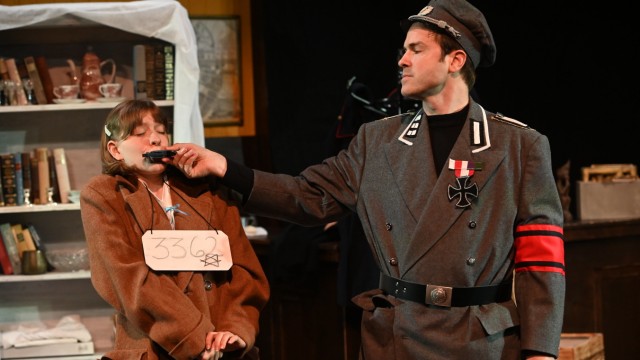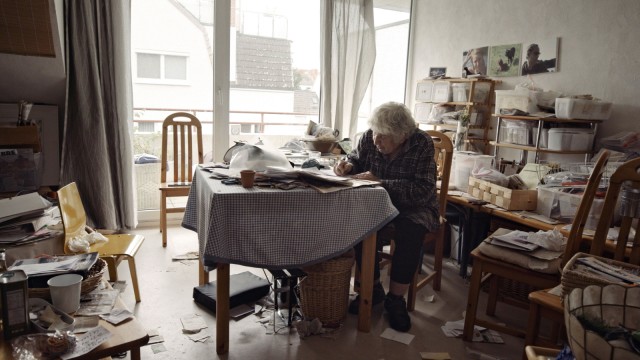Like the memories, the colors in these family photos from the 1970s fade, and a strange red-tinged gray veil covers everything. Millions upon millions of these pictures are stored in German photo albums; crackling tissue paper prevents the pages from sticking together. For the Munich artist Anja Frers, these recordings are the source material for disturbing collages. Pensioners with hefty calves of wealth stand on the viewing platform of the Olympic Tower, enjoying the magnificent view over the city, on which a Wehrmacht Junkers is currently raining down a wave of bombs.
Anja Frers’ “Grandma and Grandma, Olympic Tower 1972”, a digital collage from 2020.
(Photo: Anja Frers)
The work is part of the exhibition “Generation Transmission, pictured”, which opens on February 21st at the Pasinger Fabrik. Together with Nana Dix and Uschi Siebauer, Anja Frers examines the question of how much the Second World War, the Nazi ideology and the authoritarian educational ideals of their parents and grandparents influenced them – all three artists were born between 1962 and 1972. Her approach is usually a very personal one. Nana Dix’s grandfather, for example, was Otto Dix, who was considered a “degenerate artist” during National Socialism, was at the same time a member of the Reich Chamber of Culture and, after a temporary imprisonment in connection with the Munich assassination attempt on Hitler in 1939 the “internal emigration” withdrew. What shadows lay over her childhood? Why wasn’t the past talked about?

Her grandfather was Otto Dix: Nana Dix, “Shut up”, collage 2021.
(Photo: Nana Dix)
The show is part of an interdisciplinary event series “How we became what we are”, which deals with inherited trauma and the transfer of experiences from one generation to the next. And the question of the extent to which the narrative of a successful German reappraisal of history reflects a very deceptive self-perception. There will be theater productions, podiums, readings and films in the factory until the end of March.
The great-grandchild generation is also expressly addressed: At the start of the series, Diane Samuels’ English-language play “Kindertransport” (English Theater Frankfurt, January 31) tells of the fate of nine-year-old Hamburger Eva Schlesinger. Like 10,000 other Jewish girls and boys, she arrived in England in 1939 thanks to a British rescue operation. She grew up there with foster parents. 40 years later, her daughter Faith discovered photos of her mother’s true identity.

Shortly before the outbreak of the Second World War, nine-year-old Eva was sent to England by her parents on one of the children’s transports. Their fate is told in the English-language play “Kindertransport”.
(Photo: Martin Kaufhold/English Theater Frankfurt)
The guest performances of the Residenztheater “The Events”, February 10th) and the Kammerspiele (“Mrs. Schmidt and the Child from Kharkiv – unplugged” are also about repression, silence and the question of how it is possible to continue living after traumatizing experiences. February 12th) in the factory wagon hall. There will be a special premiere on February 28th: with their production “Gypsy Boxer” they will commemorate Madhouse Theater Company to the champion Johann Wilhelm “Rukeli” Trollmann, a German Sinto who was murdered in the Wittenberge concentration camp in 1944.

The Berlin Jew Lore was only able to survive persecution by the National Socialists because she hid in the attic as a six-year-old. In the documentary “Love Fear” she is confronted with this childhood trauma as an old woman.
(Photo: Real Fiction Film Rental)
Panels, readings and films deal with the “Silent Generation”. In Sandra Prechtel’s haunting documentary “Liebe Angst” (March 20), it is only through witnessing the camera that Lore confronts her life’s trauma shortly before her death. The Berlin Jew had survived in hiding as a child, but her mother was murdered in Auschwitz. When Lore’s daughter Kim Seligsohn, without knowing it beforehand, moves into the house next door to the hiding place, the family history gradually comes to light.
A series of events follows in April, which is directly related to the theme: The focus is on the exhibition “Dancing with the Enemy” about the life of the Dutch dancer and Auschwitz survivor Roosje Glaser.
“How we became what we are”, series of events in the Pasinger Fabrik, August-Exter-Straße 1, information at www.pasinger-fabrik.de

